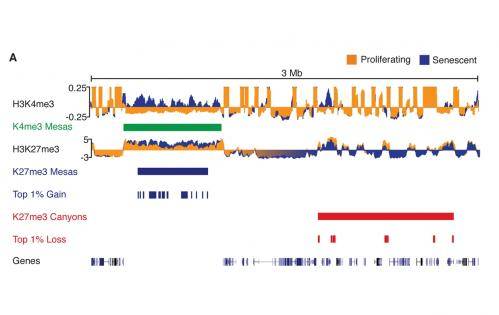Researchers from the Perelman School of Medicine at the University of Pennsylvania have found that epigenetic factors play a role in senescence. Epigenetic factors act on the structures in which genes reside, called chromatin. They found that senescent cells appear to undergo changes in their chromatin and find similar changes in cells that are prematurely aging.
Their observations take place deep within cells – inside the chromatin of a cell’s nucleus. In the chromatin, DNA is wound around proteins called histones. Enzymes called histone modifiers mark the chromatin – like using sticky notes as reminders – to open up or close down regions of the genome, which makes these areas more or less available to be “read” as a gene. (Epigenetics is the science of how gene activity can be altered without actual changes in DNA sequence.)
Shelley Berger, PhD, professor of Cell and Developmental Biology, Parisha Shah, PhD, a postdoctoral fellow in the Berger lab, and colleagues, compared differences in the presence of the genome-wide sticky notes between two lung cell populations, one at the start of proliferation, as a control, and the other at the end of its replication cycle and senescent. Berger is also director of the Penn Epigenetics Program.
They found that when a nuclear protein called lamin B1 is deleted in senescent cells, large-scale changes in gene expression, and likely chromatin, occurred. The team surmised that the loss of lamin B1 causes changes in the architecture of chromatin and this adds to the aging of cells. They report their findings in Genes & Development.
“Senescence is really a balancing act between aging and cancer,” says Berger. “While chromatin regulation and downregulation of lamin B1 have been known to be altered during senescence, how the two processes interact has been poorly understood.”
Lamin B1 is part of the lamina, a network lining the inside of the membrane of the nucleus. It provides support to keep the shape of the nucleus and also regulates DNA replication by making some areas of the genome less or more available to be translated into proteins. In the case of silencing genes, the proteins of the lamina do this by creating tight connections between parts of the chromatin and the nuclear membrane.
The Penn team was surprised by the large portion of the genome that changed its chromatin signature in senescence, particularly in the tightly bound laminar regions in the senescent cell population. In fact, nearly 30 percent of the human genome, as measured by changes in the actual sequence of nucleic acid bases, was different between the two cell populations
When comparing gains and losses of two histone modifications — the molecular sticky notes – the team found remarkable differences in the senescent cells. These differences include large-scale domains of “sticky-note”-enriched histone “mesas” and “sticky-note”-depleted histone “canyons,” as graphically depicted when comparing the gains and losses. The enriched “mesas” form at lamin B1-associated areas on the chromatin. In addition, they found that intentional lamin B1 reduction in proliferating cell populations also triggers premature senescence and, importantly, leads to chromatin “mesas and canyons” in the cells.
Fibroblast cells from patients with Hutchinson-Gilford progeria syndrome, caused by a related mutated lamin A protein, also showed the enriched marker “mesas,” suggesting a link between premature chromatin changes and accelerated cell senescence. This form of progeria is a genetic condition characterized by the dramatic, rapid appearance of aging, starting in childhood. Other researchers have found that progeria symptoms are delayed in a mouse model of the human syndrome when the mice are engineered to clear all senescent cells via apoptosis, or cell death.
Comparing cells from children with progeria and their symptom-free parents, the team found that the progeria cells have increased chromatin “sticky note” mesas in lamin regions that are not normally marked as mesas. These areas of the genome are called “permissive” chromatin. This “leniency,” of sorts, is the signature of an aging cell. The parents’ control cells do not have this permissive chromatin compared to their children’s.
Shah, the first author on this study, concludes that “our data illustrate profound chromatin reorganization during senescence and suggest that lamin B1 downregulation in senescence is a key trigger of global and local chromatin changes that affect gene expression, aging, and cancer.”
Berger adds that “once we know the chromatin changes that occur during normal aging, then we can compare and study aberrant chromatin alterations that occur in abnormal aging, including human brain degeneration, which is a growing problem in the aging human population.
“What’s more, since many human diseases exponentially increase with age – one obvious example is cancer – the goal of these studies is to provide insight into the relationship between age and mechanisms of age-related disease” says Berger.
Co-authors are also from the Institute of Cancer Sciences, University of Glasgow, UK and the Department of Biology, Penn Genome Frontiers Institute.
Story Source:
The above story is based on materials provided by Penn Medicine, Karen Kreeger.





